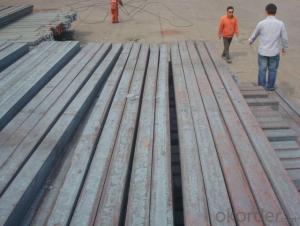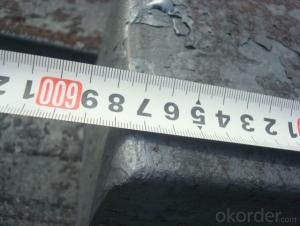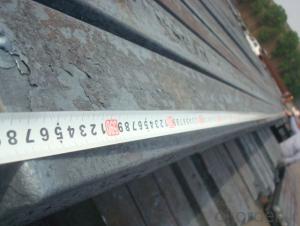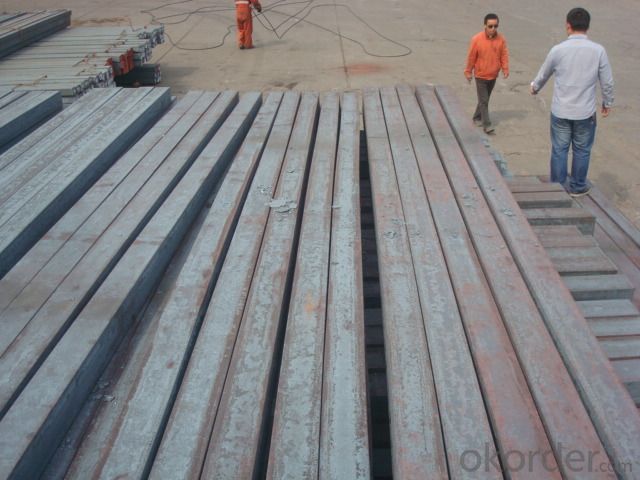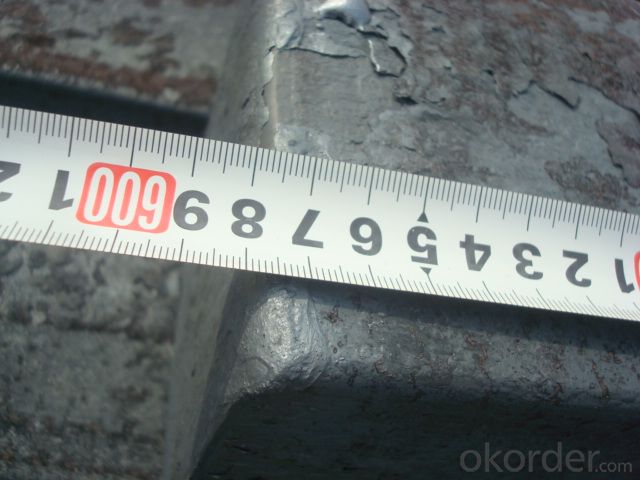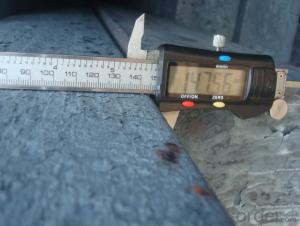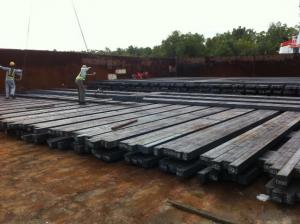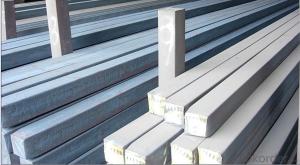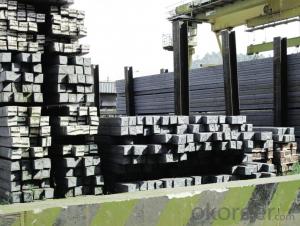Carbon Steel Billets Square Billets70mm 100mm 130mm 150mm 3SP
- Loading Port:
- Tianjin
- Payment Terms:
- TT OR LC
- Min Order Qty:
- 1000 m.t.
- Supply Capability:
- 30000 m.t./month
OKorder Service Pledge
OKorder Financial Service
You Might Also Like
STEEL BILLET
1.Brief description
Steel billet(ingot) by cogging or breakdown of semi-finished products, is the raw material of all kinds of steel mill. Billet section of square, round, flat, rectangular and abnormity of several kinds of, mainly related to the shape of rolled products.
2.Features
Rectangular billet continuous casting billet and mainly general carbon steel, low carbon low silicon cold-rolled material, high quality carbon structural steel, high strength low alloy steel, special steel, etc.
The billet is mainly divided into two kinds from the shape:
Slab: cross section width and height of the ratio of the larger, mainly used for rolling plate.
Billet: equal cross section width and height, or a huge difference, mainly used for rolling steel, wire rod. ,
Steel billets have distinct characteristics as compared with already furnished steel bars and products. Billets have a specific grain structure, which enables the metal to be processed more intricately. Steel billets are also known for their malleability and ductility, especially when exposed to varying temperatures during shaping and molding.
3.Processing
Steel billets are considered fresh and raw, and they must undergo a series of manufacturing processes before they can be used for various purposes. Billets are made by means of freezing molten liquid, and are later exposed to extremely low temperatures in order to allow the metal to take shape and solidify in chemical structure. The temperature manipulates the metal's physical properties, and tones its strength and durability. The subsequent processes provide the metal's curved mold design so that it can fit the allotted space provided by other machines, which complete the finishing procedures.
4.Pictures
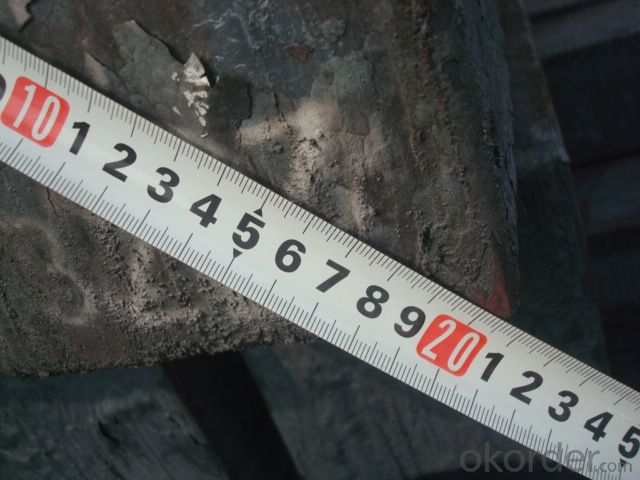
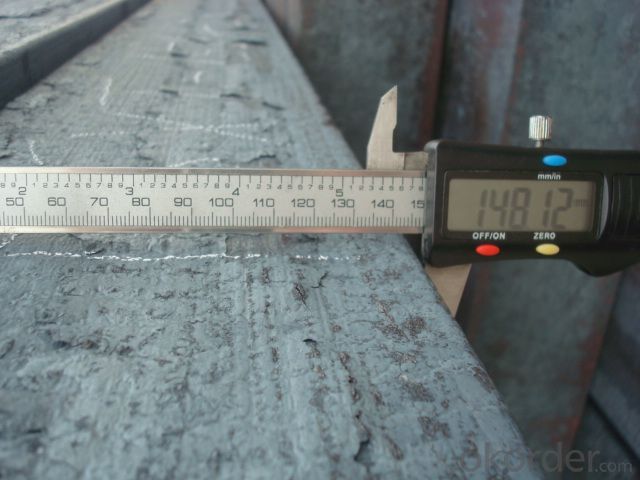
5.Usage
Billets, or ingots (as they sometimes referred to), are not of practical use until they have been formed into more functional shapes and sizes. While they have already been put in the furnace, they still require a series of shaping and molding procedures such as hot and cold working, milling and cutting before they are sold in hardware stores, or used for different applications. The unformed billets, however, can be used in striking currency such as coins and as reserves, similar to gold bars.
6.Detailed specification
Hot rolled billet steel
Size: 50x50mm-180x180mm
Steel Grade: 3SP, 5SP,Q195,Q235,Q255,Q275 Length:3m-12m
MOQ: 1000MT/size
Payment term: TT or LC
Packing: in bulk , bundle
Shipment: by container , bulk vessel
Packaging Details: bundles with steel strips or as customers's requirements
Delivery time: 15-30 days after the deposit
Loading port:Tianjin, or other port China
Origin : China
Inspection:Third party inspection before loading.
- Q: Can steel billets be used for making sculptures?
- Certainly, sculptures can be made using steel billets. Steel, being a highly versatile material, offers numerous advantages for sculpting. Its robustness and durability make it ideal for crafting large-scale sculptures that can withstand the elements outdoors. Manipulating and shaping steel billets into various forms is a simple task, enabling artists to unleash their creativity and give life to their concepts. Moreover, steel can be welded, polished, and painted, providing additional avenues for customization and artistic expression. In essence, steel billets provide sculptors with a sturdy and adaptable medium to fashion distinctive and enduring sculptures.
- Q: How are steel billets used in the manufacturing of telecommunications equipment?
- Telecommunications equipment manufacturing relies heavily on steel billets, which serve as a crucial component. These billets act as the raw material that undergoes shaping and transformation to create various components used in telecommunications infrastructure. Primarily, steel billets are used in the production of towers and masts, providing the necessary support for antennas and other transmitting and receiving equipment. To ensure strength and stability, the billets are melted and then forged or rolled into the desired shape, forming the structural members of these towers. Moreover, steel billets are also essential in the manufacturing of cable trays and cable management systems. These components play a crucial role in organizing and protecting the extensive network of cables used in telecommunications systems. By processing and fabricating the billets into cable trays, brackets, and supports, a robust and durable solution is provided for managing the complex web of cables. Furthermore, steel billets find application in the production of enclosures and cabinets that house sensitive telecommunications equipment. These enclosures safeguard the equipment from environmental factors like dust, moisture, and temperature fluctuations. By molding and shaping the steel billets into the desired size and design, a sturdy and secure enclosure is achieved. In conclusion, the role of steel billets in telecommunications equipment manufacturing cannot be overstated. Whether it is for towers and masts, cable trays, or enclosures, these billets lay the foundation and ensure the structural integrity necessary for the reliable operation of telecommunications infrastructure.
- Q: What are the potential applications of steel billets in the automotive industry?
- Steel billets have a wide range of potential applications in the automotive industry. They can be used in the production of various components such as engine parts, chassis, suspension systems, and body panels. Steel billets offer excellent strength, durability, and high melting points, making them ideal for ensuring the safety and reliability of vehicles. Additionally, their versatility allows for customization and lightweight designs, contributing to improved fuel efficiency and overall performance.
- Q: How are steel billets reheated before rolling or forging?
- Steel billets are reheated before rolling or forging by passing them through a furnace or a reheating furnace, which raises their temperature to a specific range. This process, known as billet reheating, is crucial as it improves the billets' malleability, making them easier to shape and work with during the subsequent rolling or forging operations.
- Q: How are steel billets used in the production of transmission components?
- Steel billets are an essential raw material used in the production of transmission components. These billets are semi-finished products that are typically obtained through the casting process. They are usually rectangular or square in shape and have a cross-sectional area that is larger than the final product. The production of transmission components involves shaping the steel billets into the desired forms. This is done through a series of processes like forging, rolling, or extrusion. Each of these processes is aimed at transforming the steel billets into specific shapes and sizes required for transmission components such as gears, shafts, bearings, and housings. Forging is a common method used to shape the steel billets. It involves applying heat to the billet and then using mechanical force to deform it into the desired shape. This process enhances the strength and durability of the transmission components. Rolling is another method used in the production of transmission components. In this process, the steel billets are passed through a series of rollers that gradually reduce their cross-sectional area. This helps to achieve the desired shape and dimensions of the components. Extrusion is also employed in certain cases, especially for producing complex shapes. In this process, the steel billets are forced through a die to obtain the desired form. This allows for the production of intricate transmission components such as splined shafts or valves. Once the steel billets have been shaped into the required forms, they undergo further machining processes like cutting, drilling, and grinding to achieve the final specifications. These components are then heat-treated and coated to enhance their strength, durability, and resistance to corrosion. Overall, steel billets play a crucial role in the production of transmission components by providing a versatile and reliable raw material that can be shaped into various forms. They ensure the transmission components possess the necessary strength, durability, and precision required for efficient and reliable operation in vehicles and machinery.
- Q: How are steel billets used in the construction industry?
- Steel billets are used in the construction industry as raw materials for manufacturing various steel products such as beams, columns, and reinforcing bars. They are heated and shaped into different forms to be used in the construction of buildings, bridges, and other infrastructure projects.
- Q: How are steel billets used in the manufacturing of electrical transmission equipment?
- Steel billets are used in the manufacturing of electrical transmission equipment as a key raw material. These billets are essentially solid blocks of steel that undergo further processing to transform them into various components required for electrical transmission equipment. One of the main uses of steel billets in this context is for the production of transmission towers. These towers provide the infrastructure needed to support power lines and ensure the safe and efficient transmission of electricity over long distances. Steel billets are used to manufacture the structural components of these towers, including the main vertical and horizontal members, as well as the cross arms and braces. Additionally, steel billets are also used in the manufacturing of conductors for electrical transmission equipment. Conductors are the cables that carry the electrical current between power generation stations and distribution networks. Steel billets are processed to create the necessary wires and strands that are then used to construct these conductors. The high strength and durability of steel make it an ideal material choice for these applications, as it can withstand the high tension and load requirements of electrical transmission systems. Furthermore, steel billets are used in the production of various other components used in electrical transmission equipment, such as pole line hardware, insulators, and connectors. These components are crucial for the proper functioning and reliability of the electrical transmission system, and steel billets provide the necessary strength and stability required for their construction. In summary, steel billets play a vital role in the manufacturing of electrical transmission equipment. They are used to produce transmission towers, conductors, and other essential components, ensuring the safe and efficient transmission of electricity across long distances.
- Q: What are the different heat treatment processes for steel billets?
- Steel billets can undergo various heat treatment processes, each serving a specific purpose and offering distinct advantages. Among the commonly used processes are annealing, normalizing, quenching, tempering, and case hardening. 1. Annealing: The steel billets are heated to high temperatures and gradually cooled to room temperature. This process aims to reduce hardness, enhance machinability, relieve internal stresses, and refine the grain structure, resulting in a more ductile and less brittle steel. 2. Normalizing: By heating the steel billets above the critical range and cooling them in still air, the normalizing process refines the grain structure, improves mechanical properties and machinability, relieves internal stresses, and achieves uniformity in microstructure. 3. Quenching: Rapid cooling of steel billets is achieved by immersing them in a quenching medium like oil, water, or brine. Quenching transforms the austenite phase into martensite, making the steel harder and more wear-resistant. However, it may introduce residual stresses and the risk of cracking. 4. Tempering: Following quenching, tempering is often performed to reduce brittleness and enhance toughness. The quenched steel is reheated to a lower temperature and held for a specific time period. This process relieves stresses, decreases hardness, and improves ductility without sacrificing too much strength. 5. Case Hardening: This process elevates the surface hardness of steel billets while maintaining a tough and ductile core. Carburizing and nitriding are two common methods of case hardening. Carburizing involves heating the steel in a carbon-rich environment to introduce carbon into the surface. Nitriding, on the other hand, introduces nitrogen to form a hard nitride layer. These processes enhance wear resistance and prolong the lifespan of the steel billets. These heat treatment processes allow manufacturers to customize the properties of steel billets to meet specific application requirements. By carefully selecting and implementing the appropriate process, the resulting steel billets can exhibit a wide range of mechanical properties, including hardness, strength, toughness, and wear resistance.
- Q: What are the potential applications of steel billets in the telecommunications industry?
- Steel billets have a wide range of potential applications in the telecommunications industry. One of the key applications is in the construction of telecommunication towers. Steel billets can be used to manufacture the structural components of these towers, providing strength and durability to support the weight of antennas and other equipment. Additionally, steel billets can be utilized in the production of transmission line hardware such as pole line fittings, brackets, and clamps. These components are crucial in the installation and maintenance of telecommunication lines, ensuring their stability and reliability. Moreover, steel billets can be employed in the manufacturing of underground and overhead enclosures for telecommunication cables. These enclosures protect the cables from external factors such as moisture, heat, and physical damage, ensuring uninterrupted communication. Steel billets also find application in the production of telecommunication equipment cabinets and racks. These cabinets provide a secure and organized space for housing network equipment such as servers, switches, and routers. The strength and rigidity of steel billets make them ideal for supporting heavy equipment and providing protection against environmental hazards. Furthermore, steel billets can be utilized in the construction of telecommunication infrastructure, such as base stations and equipment shelters. These structures require robust materials to withstand harsh weather conditions and provide a stable foundation for the installation of telecommunications equipment. In summary, the potential applications of steel billets in the telecommunications industry are vast and encompass various aspects, ranging from tower construction to cable enclosures and equipment cabinets. The strength, durability, and versatility of steel make it an ideal material for supporting and protecting telecommunication infrastructure and equipment.
- Q: What is the role of steel billets in the manufacturing of material handling equipment?
- Steel billets play a crucial role in the manufacturing of material handling equipment. These billets are essentially semi-finished steel products that are used as the raw material for various manufacturing processes. In the context of material handling equipment, steel billets are typically used in the fabrication of heavy-duty components such as frames, beams, and brackets. These components need to possess high strength, durability, and resistance to wear and tear in order to withstand the demanding conditions that material handling equipment often operates in. The use of steel billets allows manufacturers to create these components with the necessary mechanical properties. The billets are first heated and then shaped through processes like rolling, forging, or extrusion to produce the desired shape and dimensions. This shaping process ensures that the components have the required strength and structural integrity to handle the weight and stress associated with material handling tasks. Furthermore, steel billets offer excellent weldability, which is crucial in the fabrication of material handling equipment. The ability to weld the components together ensures that the equipment can be assembled securely and efficiently. This is especially important for equipment such as cranes, forklifts, and conveyors, where the safe and efficient movement of heavy loads is paramount. Moreover, steel billets provide a cost-effective solution for manufacturing material handling equipment. Steel is widely available, relatively affordable, and can be recycled, making it a sustainable choice. The versatility of steel billets also allows manufacturers to create components of various shapes and sizes, enabling customization to meet specific requirements. Overall, the role of steel billets in the manufacturing of material handling equipment is crucial. They provide the raw material necessary to create strong, durable, and reliable components that can withstand the demanding conditions of material handling tasks. With their excellent mechanical properties and weldability, steel billets contribute to the safe and efficient operation of material handling equipment.
Send your message to us
Carbon Steel Billets Square Billets70mm 100mm 130mm 150mm 3SP
- Loading Port:
- Tianjin
- Payment Terms:
- TT OR LC
- Min Order Qty:
- 1000 m.t.
- Supply Capability:
- 30000 m.t./month
OKorder Service Pledge
OKorder Financial Service
Similar products
Hot products
Hot Searches
Related keywords
